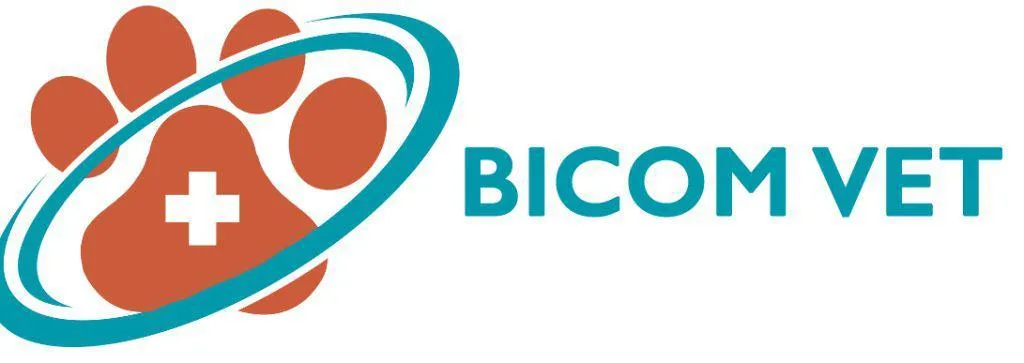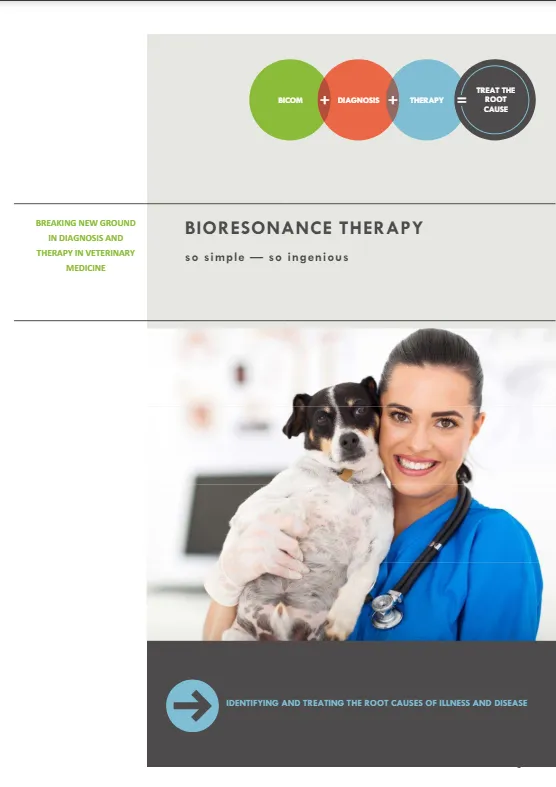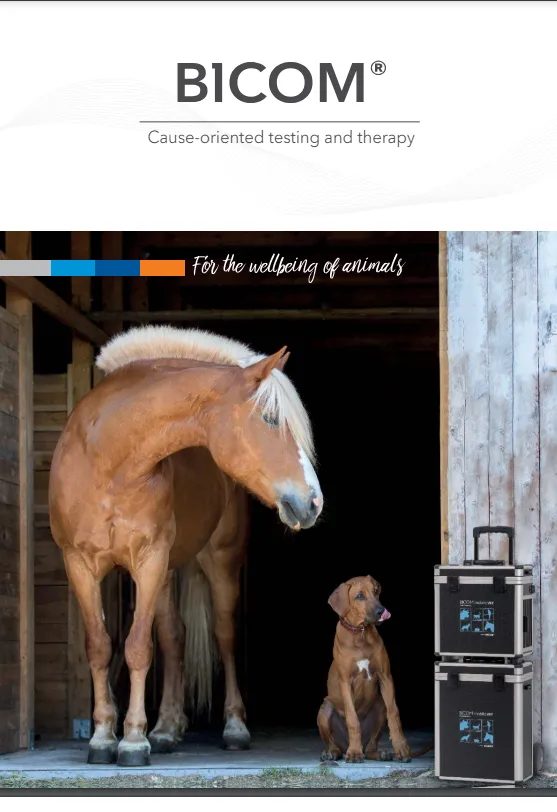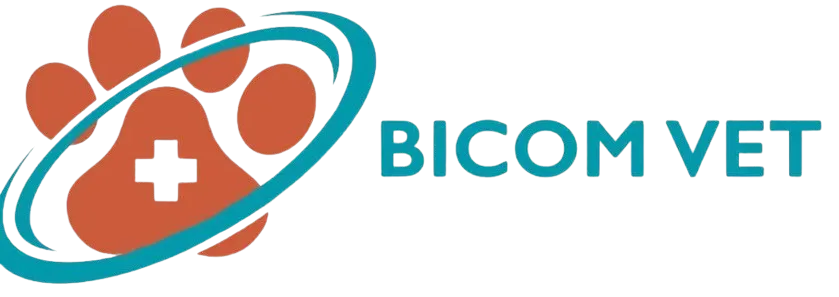BICOM® Bioresonance
Stress-free for pets and pet owners Suitable for all types of animals
There are many dogs , cats and horses suffering from health problems worldwide.
Be it problems with the musculoskeletal system, allergies and food intolerances or chronic diseases.
Sometimes, as an animal owner, you are at a loss when you can’t get any further with conventional therapy methods.
Like acupuncture or homeopathy, bioresonance belongs to the field of complementary medicine and is intended to be a useful supplement to conventional medicine.
It works with the body’s own wavelength of the four-legged friend, is used without medication and is painless to use.
Of course, not all health problems can be resolved with bioresonance. It is best to talk to a veterinarian or animal naturopath.
With our therapist finder you can find the nearest practice that can offer you BICOM® bioresonance.
Pain-free testing and therapy
Treatment with the BICOM® device is painless and stress-free. Especially sensitive animals feel very comfortable and it often happens that they completely relax and come to rest during the therapy.
Bioresonance has no harmful side effects and is used without medication.
Occasionally, initial aggravations, in what is known as the body’s initial reaction, can occur. However, these fade away after a short time.
What Pet Owners are saying..

Explore the Healing Power of Biofield Therapy for Holistic Harmony
In the health sector, complementary and alternative medicine has brought biofield therapies to the forefront. These therapies, including therapeutic and healing touch, are gaining traction among individuals seeking holistic approaches to wellness.
Biofield therapy, a unique form of energy healing, stands out as a promising method, particularly for cancer patients. This blog delves into the intriguing world of biofield therapies, uncovering their potential impact backed by clinical studies and patient experiences.
Historical Background and Development:
Biofield therapies trace their roots back to ancient healing practices. The concept, revitalized in modern healthcare, blends traditional knowledge with contemporary scientific understanding.
Recognized by the National Institutes of Health, biofield therapies have evolved, propelled by a growing body of clinical studies exploring their efficacy in integrative health.
Types of Biofield Therapies:
Therapeutic Touch:
Pioneered by practitioners in the 1970s, therapeutic touch is a non-touch biofield therapy focusing on manipulating a patient's energy field to promote healing.
Healing Touch:
Like therapeutic touch, healing touch involves a hands-on approach, guiding energy to support physical, emotional, and spiritual health.
Pranic Healing:
This form of biofield therapy may appear more esoteric, working with the biofield to cleanse and energize the body's energy centers or chakras.
Other Notable Modalities:
Diverse practices like Reiki and Qigong also fall under the umbrella of biofield therapies. Each modality has its unique approach to harnessing the body's energy for healing.
The Concept of Biofield in Health and Medicine:
The term 'biofield' in health and medicine refers to a matrix of different energy fields that are believed to affect the body's physiological and emotional health. Biofield therapies are defined by their focus on these energy fields, aiming to balance and restore health through energy manipulation.
Clinical studies in biofield therapies have begun to shed light on their potential effects, indicating that biofield therapies may reduce pain and improve quality of life, particularly in cancer patients. These therapies represent a fascinating intersection of ancient wisdom and modern science, offering new avenues for healing in today's health landscape.
Key Findings from Clinical Trials:
Clinical trials and studies of biofield therapies have yielded intriguing results. For instance, randomized clinical trials have shown positive outcomes in patients receiving biofield therapies, suggesting their potential efficacy.
Biofield Therapies and Cancer Patients
Impact on Breast and Cervical Cancer Patients:
The impact of biofield therapies on cancer patients, particularly those with breast and cervical cancer, is a growing area of interest. Clinical studies have indicated that biofield interventions can alleviate symptoms and improve the quality of life in breast cancer patients undergoing radiation therapy. These therapies work with the biofield to potentially enhance emotional and physical well-being, offering a holistic approach to cancer care.
Role in Complementary and Alternative Medicine:
Biofield therapies are increasingly recognized for their role in cancer care. They are seen as a supportive treatment, often used alongside conventional treatments like chemotherapy. These therapies provide a comprehensive care model by addressing the energy healing aspect, which is important for patients seeking integrative cancer therapies.
Biofield Therapies for Pain Management
Efficacy in Chronic Pain and Post-Surgical Recover:
Biofield therapies have shown promise in managing chronic pain and aiding post-surgical recovery. Clinical studies suggest that biofield therapies reduce pain and improve recovery outcomes, positioning them as a viable option for pain management. This is particularly significant in the context of the ongoing search for non-pharmacological pain relief methods.
Comparison with Traditional Pain Management Techniques:
When compared to traditional pain management techniques, biofield therapies offer a non-invasive and holistic alternative. Studies indicate that these therapies can complement conventional methods, offering patients a more integrated approach to pain management. This integration is key in the evolving landscape of health and medicine, where the emphasis is increasingly on patient-centered, holistic care.
Challenges and Controversies
Methodological Challenges in Research:
Researching biofield therapies poses unique methodological challenges. The personalized nature of these therapies, heavily reliant on the practitioner's skill and the individual patient's response, makes standardization for clinical trials complex. This difficulty often leads to questions about the reproducibility and validity of research findings in biofield science, a crucial factor in gaining broader scientific acceptance.
Debates on Clinical Effectiveness:
The clinical effectiveness of biofield therapies remains a hotly debated topic. While some clinical studies and randomized trials in biofield therapies suggest positive outcomes, especially in the context of complementary and alternative medicine, skepticism persists.
Critics often point to the placebo effect or the lack of large-scale, placebo-controlled randomized trials as factors undermining the perceived effectiveness of these therapies.
Addressing Skepticism in the Medical Community:
Skepticism in the medical community regarding biofield therapies primarily stems from the challenges of demonstrating clear, consistent outcomes through conventional scientific methods.
Biofield therapy proponents advocate for more robust clinical trials and interdisciplinary research. They aim to strengthen the scientific foundation of these therapies, thus fostering a more accepting and understanding environment within the broader health and medicine community.
Patient Perspectives and Experiences
Case Studies and Testimonials:
Documented case studies reveal how these therapies have played a role in their holistic health journey. For instance, a breast cancer patient undergoing radiation therapy shared how biofield treatment significantly alleviated her pain and anxiety, illustrating the impact of biofield therapies. Such testimonials underscore patients' personal experiences and highlight these therapies' potential benefits.
The Role of Biofield Therapies in Holistic Health:
The role of biofield therapies in holistic health is gaining attention, especially in integrative cancer therapies. Patients report a sense of enhanced emotional and physical well-being when these therapies are integrated with conventional treatments. Clinical studies of biofield therapies suggest they aid in managing symptoms and improving life quality, making them a valuable component of comprehensive health care.
Conclusion
Biofield therapy, an emerging domain in contemporary health and medicine, encompasses various practices like Therapeutic Touch, Healing Touch, and Pranic Healing. Historically rooted yet evolving, these therapies focus on manipulating energy fields for health benefits.
Clinical trials, albeit methodologically challenging, indicate promising results, particularly in cancer care and pain management. These therapies offer complementary alternatives in treating conditions like breast and cervical cancer and chronic pain, often integrating with conventional methods.
Debates regarding their clinical effectiveness and scientific validity persist, facing skepticism within the medical community. Many patients report positive experiences, highlighting biofield therapy's role in holistic health and its growing appeal as an integrative health approach. This underscores the need for more rigorous research to fully understand and validate the efficacy of biofield therapies in healthcare.
To find a vet near you please complete the form below
Quick Links








Facebook
Instagram
Mail